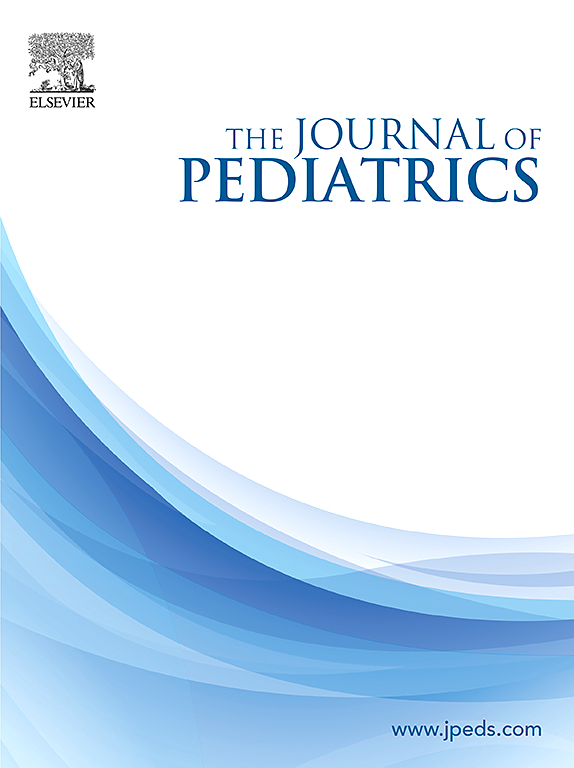神经发育障碍患者手术流口水治疗的长期疗效:一项回顾性队列研究。
IF 3.5
2区 医学
Q1 PEDIATRICS
引用次数: 0
摘要
目的:比较下颌下导管移位(SMDR)、下颌下腺切除术(SMGE)和下颌下导管结扎(SDL)治疗神经发育障碍患者前流涎的远期疗效。研究设计:对荷兰因流口水而接受手术的患者进行回顾性队列研究。所有参与者在8周和32周后接受随访。术后至少一年填写问卷进行长期随访。流口水的视觉模拟量表(VAS)是主要观察指标。次要结果包括流口水商和流口水严重频率量表。采用重复测量方差分析(Repeated measures ANOVA)来评估每种手术内及手术间的结果。结果:本研究共纳入2000年至2021年间到访唾液控制诊所的255例患者。对于长期随访的VAS, SMDR平均降低44.9分(p < 0.001), SMGE平均降低27.2分(p < 0.001), SDL平均降低25.4分(p < 0.001)。与32周相比,SMGE (8.6, P = 0.036)和SDL (8.5, P = 0.047)的长期VAS增加了手术内差异,但SMDR没有(2.9,P = 0.46)。三种手术方式比较,SMDR术后远期疗效稳定,SMGE和SDL的VAS均升高(平均差异18.9,P = 0.011), SDL均升高(平均差异18.5,P = 0.013)。结论:所有手术后流口水、DQ和DSFS的VAS评分均下降。长期来看,SMDR的预后优于SMGE和SDL。我们的数据显示SDL和SMGE后流口水部分复发。本文章由计算机程序翻译,如有差异,请以英文原文为准。
Long-Term Outcomes of Surgical Drooling Treatment in Individuals with Neurodevelopmental Disabilities: A Retrospective Cohort Study
Objective
To compare the long-term treatment outcomes of submandibular duct relocation (SMDR), submandibular gland excision (SMGE), and submandibular duct ligation (SDL) for the treatment of anterior drooling in individuals with neurodevelopmental disabilities.
Study design
A retrospective cohort study was conducted with patients from the Netherlands who received surgery for drooling. All participants received follow-up after 8 and 32 weeks. A questionnaire was completed at least 1 year postsurgery for long-term follow-up. Visual analog scale (VAS) for drooling was the primary outcome. Secondary outcomes included the Drooling Quotient and the Drooling Severity and Frequency Scale. Repeated measures ANOVA was employed to assess the outcomes within and between each type of surgery.
Results
A total of 255 patients who visited the Saliva Control Clinic between 2000 and 2021 were included in this study. For the VAS at long-term follow-up, a mean reduction was observed of 44.9 points for SMDR (P < .001), 27.2 for SMGE (P < .001), and 25.4 for SDL (P < .001). VAS increased by within-surgery difference at long-term compared with 32 weeks for SMGE (8.6, P = .036) and SDL (8.5, P = .047), but not for SMDR (2.9, P = .46). When comparing the three types of surgery, the outcomes after SMDR remained stable in the long term, while the VAS increased for SMGE (mean difference 18.9, P = .011) and SDL (mean difference 18.5, P = .013).
Conclusions
VAS for drooling, Drooling Quotient, and Drooling Severity Frequency Scale decreased after all surgical procedures. SMDR showed superior outcomes over SMGE and SDL in the long term. Our data suggest partial recurrence of drooling after SDL and SMGE.
求助全文
通过发布文献求助,成功后即可免费获取论文全文。
去求助
来源期刊

Journal of Pediatrics
医学-小儿科
CiteScore
6.00
自引率
2.00%
发文量
696
审稿时长
31 days
期刊介绍:
The Journal of Pediatrics is an international peer-reviewed journal that advances pediatric research and serves as a practical guide for pediatricians who manage health and diagnose and treat disorders in infants, children, and adolescents. The Journal publishes original work based on standards of excellence and expert review. The Journal seeks to publish high quality original articles that are immediately applicable to practice (basic science, translational research, evidence-based medicine), brief clinical and laboratory case reports, medical progress, expert commentary, grand rounds, insightful editorials, “classic” physical examinations, and novel insights into clinical and academic pediatric medicine related to every aspect of child health. Published monthly since 1932, The Journal of Pediatrics continues to promote the latest developments in pediatric medicine, child health, policy, and advocacy.
Topics covered in The Journal of Pediatrics include, but are not limited to:
General Pediatrics
Pediatric Subspecialties
Adolescent Medicine
Allergy and Immunology
Cardiology
Critical Care Medicine
Developmental-Behavioral Medicine
Endocrinology
Gastroenterology
Hematology-Oncology
Infectious Diseases
Neonatal-Perinatal Medicine
Nephrology
Neurology
Emergency Medicine
Pulmonology
Rheumatology
Genetics
Ethics
Health Service Research
Pediatric Hospitalist Medicine.
 求助内容:
求助内容: 应助结果提醒方式:
应助结果提醒方式:


